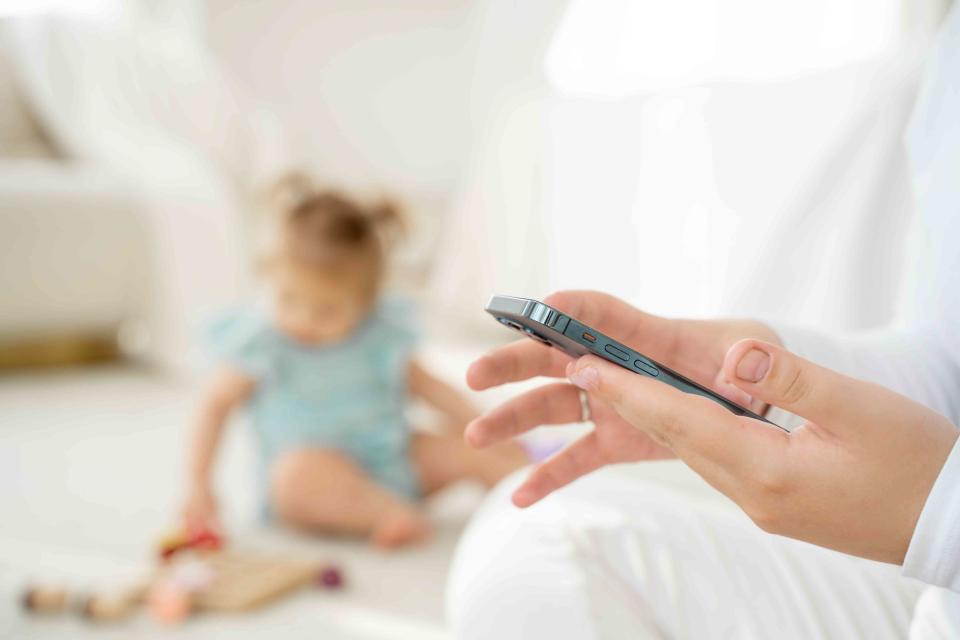What Is Phubbing and How Does It Affect Kids?
Learn all about this common yet harmful phone habit here.

Maria Levkina
Medically reviewed by Samantha Mann
Have you ever been out with a friend for coffee and they start scrolling on their phone mid-way through a conversation? We’ve all been there—and it's okay if this situation left a bad taste in your mouth. But this phenomenon, also known as “phubbing,” doesn't just affect grown peers—it happens between caregivers and children, and it affects kids more than you might think.
A few months ago, TikTok user and licensed mental health counselor, @StephAnne221 posted a video highlighting the repercussions of not being attuned with a child in favor of a phone. Although it may seemingly look harmless, it can actually be quite harmful if children experience feelings of rejection or being snubbed, hence the term “phubbing.”
To delve deeper into the phubbing phenomenon, we spoke with therapists and licensed mental health professionals about what it is, how it affects children, and ways to limit phone usage for a more healthy family dynamic.
What Is Phubbing?
Phubbing refers to when someone snubs another person IRL in favor of being on their phone. The term “phubbing” was coined in Australia as part of a 2012 campaign by the Macquarie Dictionary to describe a growing trend of social behavior where people ignore those around them while scrolling on their smartphones.
Dr. Jenny Woo, cognitive science researcher and creator of the 52 Essential Relationship Skills, describes parental phubbing as the habit of parents focusing on their phones instead of interacting with or paying attention to their children. A 2022 study showed that parental phubbing was significantly correlated with parent–child attachment, ego depletion, and learning burnout.
Related: The Age-by-Age Guide to Bonding with Your Baby
How Does a Parent or Caregiver's Phone Habits Impact Kids?
As you can imagine, a caregiver's phone habits has a significant impact on kids.
“When caregivers prioritize their phones over interacting with their child, what can get communicated to that child—and internalized by that child—is that the phone is more valuable, engaging, interesting, and important than them,” says Michelle Felder, LCSW, founder and CEO of Parenting Pathfinders.
This correlates to the term “still face,” which was derived from a psychological experiment conducted in the 1970s. This experiment demonstrated the impact that a disrupted parent-child interaction or a sudden lack of social engagement from a caregiver has on an infant—similar to when a parent scrolls their phone in front of a child.
“In the experiment, when a parent was abruptly unresponsive and adopted a still, emotionless facial expression and demeanor, infants displayed signs of confusion and distress,” says Felder. “Parent-child interactions play a huge role in shaping a child's social and emotional development, and this experiment underscores the importance of social connections and being emotionally responsive to a child’s needs.”
Additionally, Dr. Nikki Hurst, principal therapist and clinical product manager at Embodied, Inc, notes that phubbing can also cause critical delays in language development and learning of social skills and behaviors. More specifically, mother phubbing has also been significantly correlated with children’s emotional and behavioral problems.
Related: 11 Effortless Ways to Show Your Child You Love Them
How to Cut Down on Your Phone Habit and Model Mindful Tech Use
While all of the data can sound scary, it's important to know that there are ways to make changes at home if you're worried about the impact your phone usage has on your children. If you’re looking to cut down on your phone-scrolling habit, our experts have provided some tips that you can work on implementing into your daily routine.
Create Phone-Free Spaces
Woo suggests designating specific areas in the house to be phone-free so you can pay full attention to the people around you. “When parents need to use their phones while with their children in these spaces, they can explain what they’re using them for, demonstrating that it’s for a specific purpose rather than the act of aimlessly scrolling and browsing,” she adds.
Some ideas for phone-free spaces include the dining room or playroom. It doesn’t really matter where the space is, as long as there is a designated area.
Set Boundaries
For many parents, phone use can be work-related. In these cases, Hurst recommends creating stricter boundaries around work and phone use when off the clock. “Once those boundaries are set, stick to them and do not check work emails or messages until the next working day,” she says.
Set Limits on Social Media Apps
For those individuals who get caught up scrolling through Instagram or TikTok, Hurst suggests setting limits on the social media apps that can be most distracting. “Mute notifications after a certain time of day, or put your phone on “do not disturb” mode to help limit unwelcome distractions,” she adds.
Even if your child is too young to have a phone of their own, they likely will one day. Keep in mind that they are frequently observing you, and consider what you'd like to model for them as they grow older.
For older children, if you have concerns about emotional development or behavior that you may have noticed, it's always important to reach out to a pediatrician or health care provider. Ultimately, smartphones are a part of our lives—and will be part of our kids' lives. But with some careful attention, boundary-setting, and role modeling, caregivers can be sure that their phone usage doesn't impact their children.
Related: The 5 Biggest Social Media Mistakes You're Making as a Parent
For more Parents news, make sure to sign up for our newsletter!
Read the original article on Parents.

